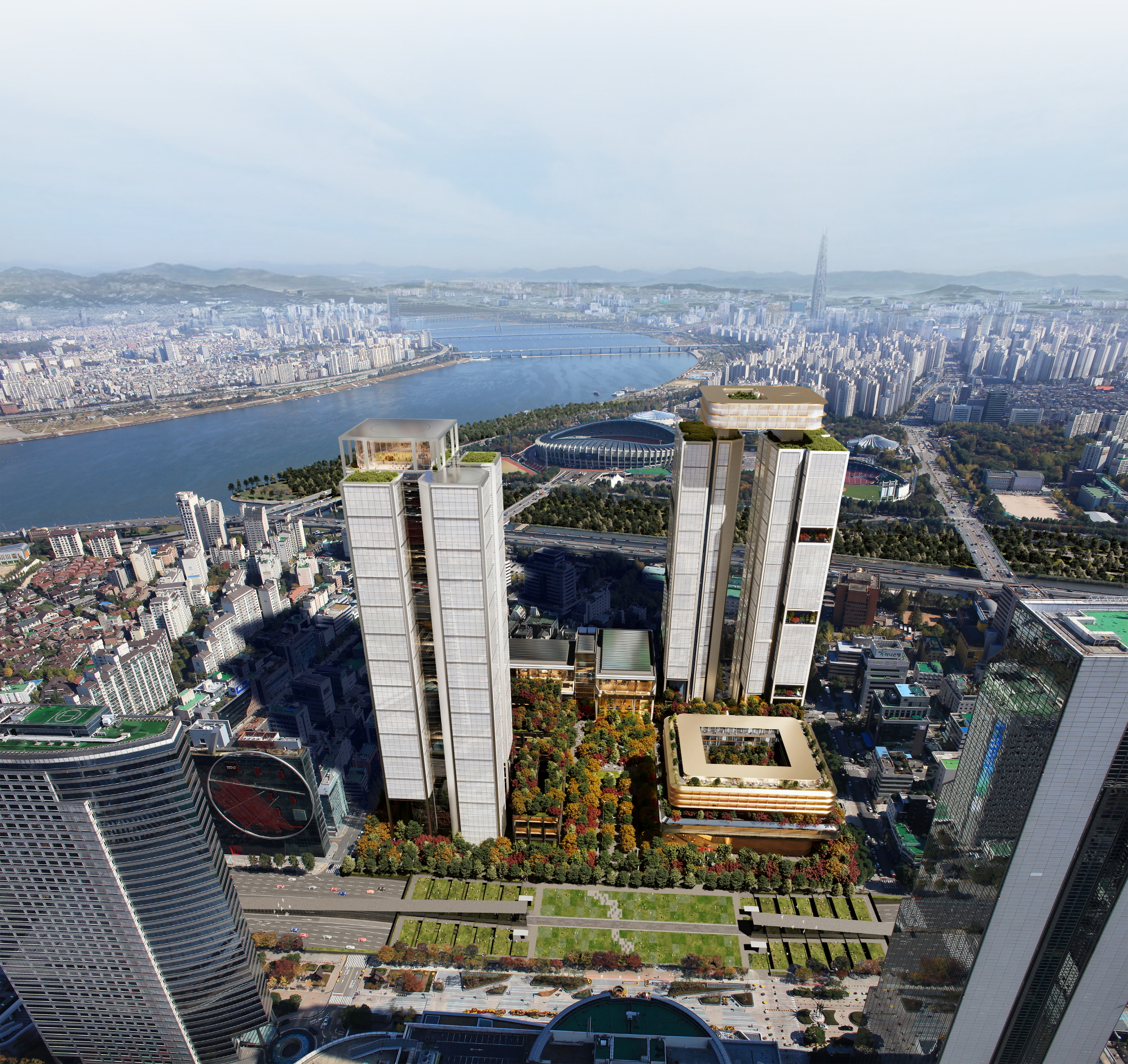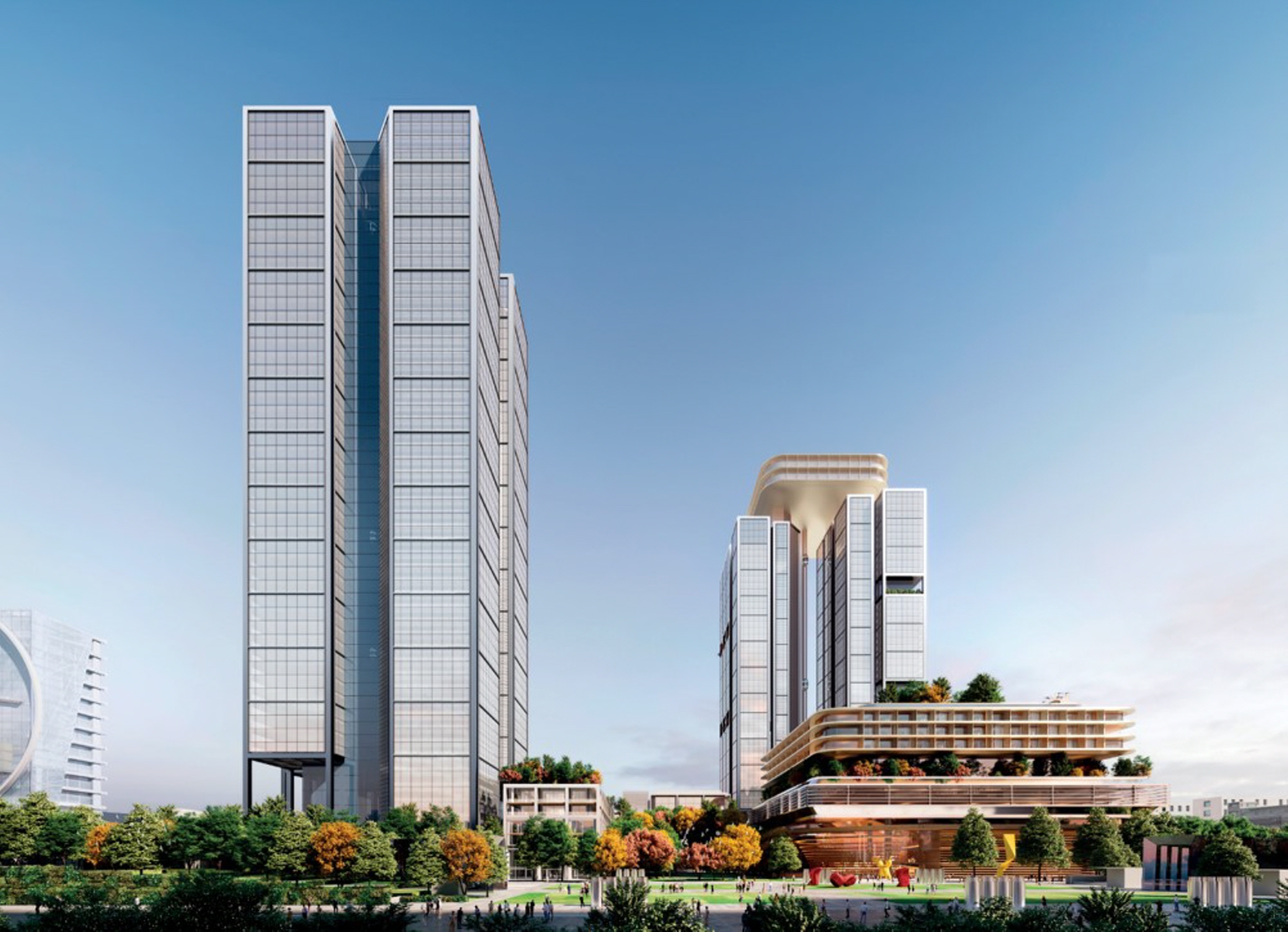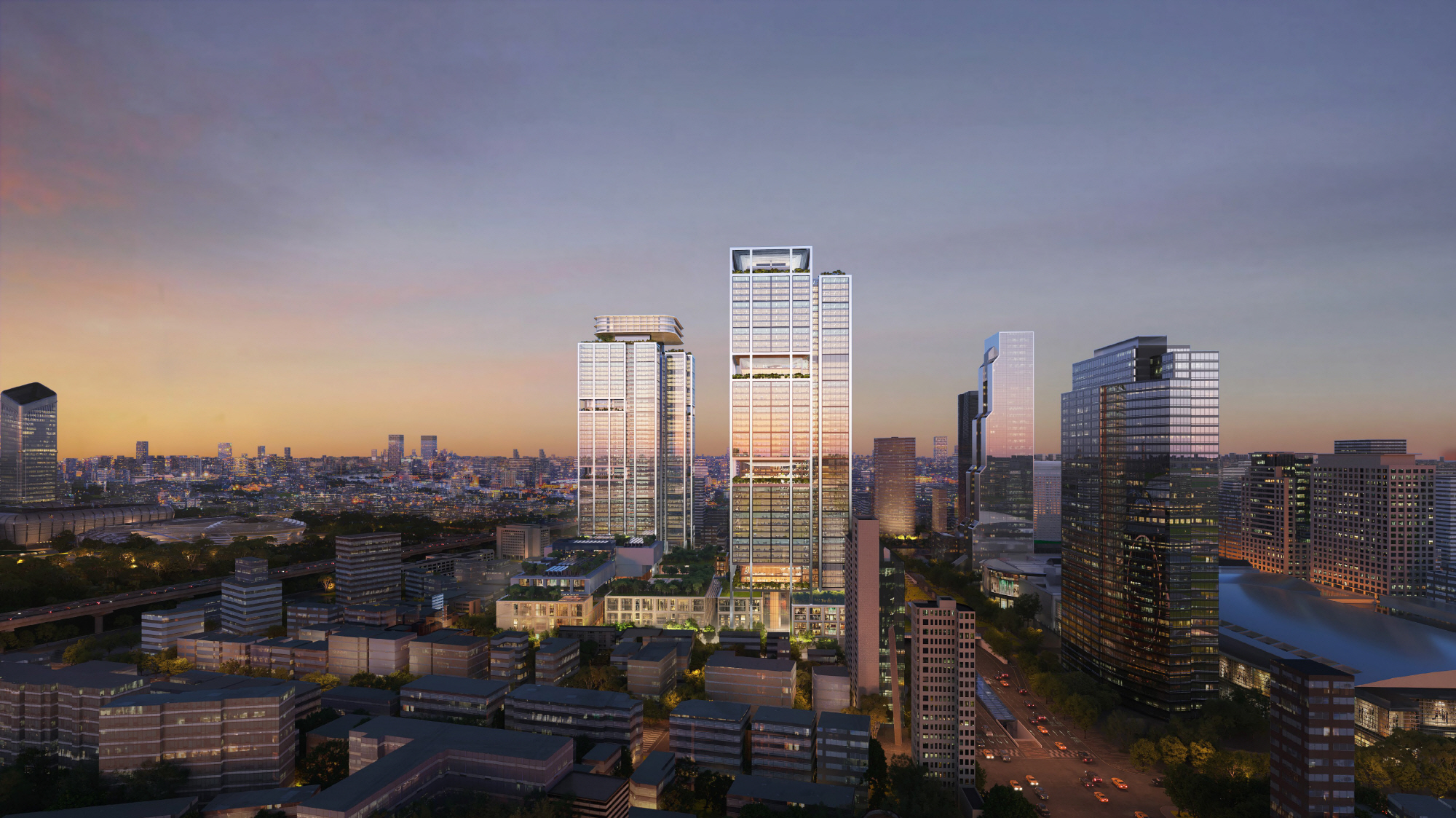
Hyundai Motor Group is creating a new global innovation hub for the future mobility industry in Seoul’s Samsung-dong, named the “Global Business Complex (GBC)”. This space will also serve as a large green area and a citizen-friendly cultural landmark.
The name has been updated from the previous ‘Global Business Center’ to ‘Global Business Complex’ to emphasize its character as an eco-friendly facility for citizens.
On the 20th, Hyundai Motor Group unveiled the conceptual design overview of GBC, which embodies sustainable future values where innovative technology coexists with nature.
GBC will consist of six buildings: two towers, each 242 meters tall with 55 floors, and four low-rise buildings that will host various programs, including MICE (Meetings, Incentives, Conventions, Exhibitions) and cultural/convenience facilities.
The two tower buildings, which are the main office facilities, are arranged diagonally within the site to ensure visual openness, while a lush urban forest for public enjoyment will occupy the center of the complex.
The low-rise buildings dedicated to exhibitions, conventions, performance spaces, and hotels will create a citizen-friendly multifunctional cultural space that connects organically with the urban forest.
■ The tower buildings will feature high-tech office spaces integrating mobility, sustainable, and digital infrastructure technologies.
Specifically, the tower buildings will be constructed as high-tech office facilities where renewable energy, carbon emission reduction, and future mobility technologies like autonomous driving, robotics, PBV (Purpose Built Vehicle), and UAM (Urban Air Mobility) are integrated into the building infrastructure.
A data-driven operation style utilizing advanced digital technologies such as big data, cloud computing, artificial intelligence, digital twins, and the Internet of Things will enhance productivity, save energy, reinforce security and safety, and maximize user convenience and satisfaction.
In particular, the design will prioritize flexible workspaces optimized for horizontal communication, sharing, collaboration, and networking, thus creating a prime office complex where various tenant companies, including Hyundai Motor Group, can explore new business opportunities together.
Hyundai Motor Group envisions GBC as a testing ground for future new businesses and a mobility innovation cluster that generates synergy through collaboration with global enterprises, specialized consultants, and startups.
The upper levels of the two towers will house lookouts where visitors can take in panoramic views of key Gangnam attractions like the Han River, Jamsil, Bongeunsa, and Seonjeongneung, along with a luxury hotel.
The design of the tower buildings prioritizes harmonious skyline formation and open views with the surrounding area, applying the concept of ‘Timeless Heritage’ that signifies enduring value through time.
The design is characterized by its simple and concise aesthetics, focused on functionality and utility while excluding excessive decorative elements.
■ Multifunctional cultural space organically connected to the urban forest … Enhancing citizen convenience and experiential opportunities.
The revised GBC design emphasizes the placement of large green spaces at the center of the complex, providing a unique characteristic.
Unlike typical green spaces that appear as an accessory to the buildings, this urban forest represents a shared public space coexisting with the community.
Designed under the concept of ‘Urban Forest Cityscape’, this urban forest cityscape serves as a tranquil refuge where citizens can pause and seek inspiration.
Moreover, it is expected to improve citizens’ quality of life by alleviating urban heat island effects, reducing fine dust, and isolating traffic and ambient noise.
Through the urban forest in the center of GBC, a pedestrian network will be seamlessly created, connecting Coex~Yeongdongdaero Transfer Center~GBC~Tancheon~Jamsil MICE~Han River, serving as a hub in the ‘International Exchange Complex’.
The low-rise sections for exhibitions, conventions, performance venues, and hotels will increase citizen accessibility and usability by being organically connected to the urban forest, and will be expanded in scale compared to the original plans, enabling citizens to enjoy more spacious environments.
The exhibition and convention facilities will be equipped with various business-friendly infrastructures capable of hosting diverse events including large international conferences, thereby playing a key role in establishing Seoul’s status as a global business center.
Additionally, a specialized exhibition space will be operated to provide tailored programs for citizens and local communities of all ages, designed to foster curiosity and creativity through unique experiences related to scientific principles in everyday life, especially focusing on future mobility technologies.
The performance venues will also be developed as landmarks of Korea’s cultural scene. By utilizing advanced construction methods that accommodate various genres, a unique experience will be offered while planning a diverse lineup of performances and attractive content to meet the cultural and artistic expectations of visitors.

Additionally, various programs will be supported as part of corporate social responsibility activities, including sponsorship for underprivileged and young artists and cultural and artistic experience education for local communities.
In this manner, GBC is expected to serve as a global cultural hub representing the future of Seoul, where the urban forest and multifunctional cultural spaces harmoniously combine.
The design of GBC is being handled by the renowned British firm ‘Foster + Partners’, known for its eco-friendly architectural techniques.
Norman Foster, the lead architect of Foster + Partners, is a globally recognized sustainable architect who emphasizes harmony between humanity and nature. He has received numerous accolades, including the Pritzker Prize, considered the Nobel Prize of architecture, and several gold medals from the Royal Institute of British Architects and the American Institute of Architects. Some of his notable works include the ‘Bloomberg European Headquarters’ in the UK, ‘Apple Park’ in the US, and ’50 Hudson Yards’.
A representative from Hyundai Motor Group stated, “GBC will be recognized as Korea’s representative landmark strengthened in future-oriented design, sustainability, innovation, and public benefit,” adding, “We anticipate prompt permitting from the city of Seoul to successfully advance the GBC project.”
■ A landmark for South Korea and Seoul … Expectation of contribution to economic activation through simplified approval procedures.
As a landmark representing South Korea and Seoul, GBC is a project that holds substantial socioeconomic value in terms of job creation and invigorating the economy, and active support from the authorities such as the city of Seoul is anticipated.
Hyundai Motor Group plans to execute the same level of investment for establishing advanced technical infrastructure and reinforcing public sustainability, suggesting that the GBC project will significantly contribute to the revitalization of the domestic economy once implemented.
In fact, based on the original project plan, the production inducement effect of the GBC project has been estimated to be about 265 trillion won, bringing about an employment inducement effect of 1.22 million jobs and a tax revenue increase of 1.5 trillion won.
If the city of Seoul completes the approval process by the second half of next year, considering the typical approval period, approximately 4.6 trillion won will be invested and 9,200 new jobs are expected through the GBC project by 2026.
By 2030, a total investment of 19.5 trillion won is anticipated, resulting in the cumulative creation of about 56,000 jobs.
The public contribution amount that Hyundai Motor Group is responsible for is expected to exceed 21 trillion won, reflecting inflation from the previous level of about 17 trillion won.
Following the public contribution agreement with the city of Seoul, Hyundai Motor Group is diligently fulfilling public contribution projects such as the remodeling of the Yeongdongdaero transfer center and the Jamsil Sports Complex, in accordance with the city’s requirements.
The commencement of the GBC project is also expected to facilitate the smooth execution of the ‘Seoul International Exchange Complex Project’, which is evaluated as a historical milestone that will reshape the center of Gangnam.
Experts in the construction industry project that since the GBC design modification focuses on changes related to building height, design, and construction plans, it may expedite the approval process.
A construction industry expert noted, “The GBC site has been designated as a general commercial area, and the designation changes have been finalized; major urban planning matters such as the floor area ratio and building coverage ratio have already been determined.” He added, “If the design change complies with urban planning matters, the approval process can be streamlined.”

Lee Sang-jin daedusj@autodiary.kr

